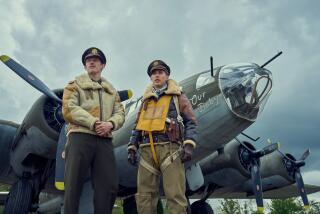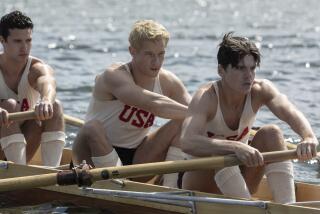Dangerous for all on board
- Share via
At the outset of each episode of “Swords: Life on the Line,” the camera flashes past a monument to fishermen who’ve died in the line of duty. But where will they build the monument to the camera people and field producers who might someday lose their lives documenting their travails for television audiences?
More so than “The Deadliest Catch,” the show on which it is most closely modeled, or any of the several subsequent tough-man employment docu-series that have landed in its wake, “Swords: Life on the Line” (Discovery, 9 p.m. Tuesdays) reminds of just how dangerous the work of documentary can be. Lenses are soaked and camera angles kicked about by yawing boats; one can almost sense the frustration of the people holding the equipment.
That’s in part attributable to what they’ve got to film. “Swords” follows four boat crews of varying degrees of seriousness, fishing difficult waters near the Grand Banks (off Newfoundland) and the Georges Bank (off the Gulf of Maine). These boats -- Eagle Eye II, Big Eye, Seahawk, Frances Ann -- specialize in long-line fishing, in which a continuous line, approximately 30 miles in length, is laid down in the ocean, baited with around 1,000 hooks and tagged with beeping buoys. It’s left overnight and then reeled in, with swordfish attached, they hope. (Or in some cases, bluefin tuna, which brings in more money per pound but is not as common.)
Like much repetitive labor, there is only so much sustained thrill to be found in watching its execution, leaving the narrative tension in the hands, and mouths, of the crews. On this count, entertainment value is inversely proportional to fishing experience.
Most memorable is Ben, a greenhorn on the Frances Ann, who’s never worked on a fishing boat before. Blond, lanky and a surfer, he’s indescribably awkward navigating the deck and the fishing gear, incurring the ire of his captain, Rick, and his best friend, Lemmie, who recommended him for the job. (Why any boat would take a rookie on such a long, risky mission is never explained.)
Though the work is exceedingly dangerous -- the Grand Banks was the location for the events chronicled in “The Perfect Storm” -- it’s rarely dwelt upon except in moments of small tragedy. Kenn, a crew member on the Eagle Eye II, cuts his finger gutting a fish and then later slips and injures his wrist, forcing the boat back to shore to offload him. Commenting on the slippery conditions on the Seahawk, Mike, one of the wizened crew members, notes, “Dorothy Hamill should be on this deck.”
Watching Mike slide across the ship is a reminder that even with computers to divine weather patterns and ocean temperatures and radar to track buoys, this is archaic work, a tremendous amount of hands-on labor in the service of a relatively small task.
And even with all the technological advances available to the crew, some parts of the job remain Stone Age: In next week’s episode, a buoy goes missing because the identification numbers and order of deployment have been scrawled, incorrectly, on a paper plate.
Nevertheless, most ships find a rhythm, taking in reasonable hauls that are dutifully counted and displayed on screen, leader-board style, at the end of each episode, making this a show with champions but no heroes.
Or at least, no heroes who can speak. Intentionally or otherwise, “Swords” renders its prey noble. Underwater cameras capture the struggles of the fish caught on hooks. When a snagged fish is pulled next to the boat by crew members, its gills flap, fighting for a breath, and its beak points to the sky as its yanked on board. Then, as the fish is laid flat on the deck in preparation for gutting, it looks regal, like a weapon, decommissioned -- its own monument to itself.
--
More to Read
The complete guide to home viewing
Get Screen Gab for everything about the TV shows and streaming movies everyone’s talking about.
You may occasionally receive promotional content from the Los Angeles Times.






